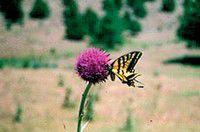Weed watch: Musk thistle drops sturdy seeds
Published 4:00 pm Tuesday, March 25, 2003

- A bright purple flower of the Musk thistle attracts a butterfly. The Eagle/DICK FIELD
Musk thistle (Carduus nutans) is a biennial and occasionally a winter annual, which grows up to 6 feet in height. The leaves are dark green and spiny. In Grant County, the rosette leaves have white or gray margins. This distinguishes it from other biennial thistle such as Scotch thistle and Bull thistle. The flowers are generally rose to purplish in color and tend to lean over on the stem, which has given it an alternate name of Nodding thistle.
Trending
Musk thistle was introduced from Europe or Asia in the 1850s and now occurs throughout most of the states and southern Canada. In Grant County it is found in disturbed farmland, rangeland and alongside roads near Izee, the South Fork of the John Day River and Ritter. Unconfirmed reports have it in Bear Valley.
The weed regenerates by seed only, with single plants producing up to 18,000 seeds which 1/3 to 2/3 are well enough developed to germinate. Studies have shown that 90 percent of one-year-old seeds, if placed in a suitable seedbed, will germinate. The seeds can, however, remain dormant for up to 10 years. Seeds are dispersed by wind, water, birds and small mammals. Field trials have shown seeds can travel up to 300 feet in a 12 mph wind. The weed can form dense stands up to 60,000 plants per acre and the stands can be self perpetuating because bare ground is near the ideal seed bed. Musk thistle does not tolerate dense shade.
Musk thistle can be controlled by several means. Since it is a biennial, cutting the plant just below the earth surface in its rosette or bolting stage can control it. It generally will not sprout. In the rosette stage it can be controlled with a variety of herbicides. There were biological control agents available, however, the insects were found to attack other native thistles, so its use was discontinued.
Trending
The populations of Musk thistle in Grant County are small enough and should allow the weed to be eradicated with cooperative efforts. Noxious weed control in Grant County is being accomplished on a voluntary basis. If you need assistance, contact Grant Weed Control at 575-1554.
Dick Field is coordinator of the Grant Weed Control. He can be contacted at 575-1554.









